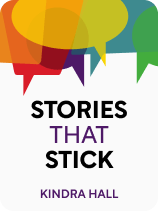

This article is an excerpt from the Shortform book guide to "Stories That Stick" by Kindra Hall. Shortform has the world's best summaries and analyses of books you should be reading.
Like this article? Sign up for a free trial here.
How do you collect stories that will wow your audience? How do you choose the right story for the appropriate situation?
Stories aren’t useful if you’re not telling them to the right people at the right time. Stories That Stick by Kindra Hall has stellar advice for choosing the best stories for your audience so you can get your point across.
Below you’ll learn how collecting stories can be an easy process if you just know where to look.
How to Know What Story to Tell
According to Hall, the trick is finding the right story at the right time for the right purpose. She explains that to collect stories, you should be clear on the message you want to communicate and then find the story that most effectively articulates that message.
As you’re deciding what story to tell, Hall recommends considering the following questions:
- Who’s the story for?
- How do you want the story to change them?
For example, if you’re speaking to an audience of potential investors and you want them to feel confident about investing in your vision, tell your founder’s story. Help them see the resilience of the person behind the product. Or, if you’re speaking to customers and you want them to see that they are part of a global movement, tell a purpose story—connect them to the deeper meaning of your company.
(Shortform note: Implicit in Hall’s argument is the assumption that stories are tools for good. However, stories can also have a dark side: Leaders and organizations can use stories to manipulate people and push them toward extremism. As you craft your own stories, consider their potential impact on their intended audience.)
How to Collect Stories
Hall argues that to effectively use stories to address the challenges facing your company, you need a stockpile of stories to choose from. Telling a compelling story, she explains, relies on having a bank of stories at your disposal and then pulling out the perfect story at the perfect moment. She recommends starting to build your story bank right away.
(Shortform note: Building your story bank doesn’t have to be a solitary project. Storytelling For Good, a storytelling consulting firm, suggests that team members work together to create systems and structures to collect and organize their stories. The firm says that after identifying a way to archive your stories, you should create a shared taxonomy that will allow you to label and organize all your content and ensure that the database is open, accessible, and searchable by things like keyword, author, date, or place.)
If you think this sounds intimidating, you’re not alone. According to Hall, many people go through life believing that they don’t have any stories to tell or that their stories aren’t worth hearing. Hall adamantly disagrees and emphasizes that everyone has stories worth sharing.
(Shortform note: Some experts argue that it’s especially important to share stories from marginalized communities, which are frequently underrepresented in the media. This lack of representation has the potential to lead to stereotypes and unconscious bias in society at large, which can further reinforce the idea some people’s stories aren’t worth sharing. Sharing stories from marginalized communities may interrupt this cycle.)
So where do you start collecting stories? Hall recommends brainstorming as many story ideas as possible without judging them or thinking about whether they’ll be useful. If you’re feeling stuck, write down a list of important people, locations, or objects, and see what comes up—many good stories are associated with them. Firsts or major obstacles are also often fruitful ground for storytelling. For example, think about the first time you made a public mistake or a time you accomplished something that seemed impossible.
(Shortform note: Judging your ideas will kill your brainstorming process. The goal of a brainstorming session is to generate as many ideas as possible, and judgment and analysis at this stage can stunt idea generation and limit creativity. Instead, go into your brainstorming session with an open mindset and put any judgment and filters aside.)
You can also gather stories from other people. You don’t have to be the only source. You can build your list of stories by asking other people questions. Hall notes that general questions about an experience rarely elicit a worthwhile story (for example, “What was summer camp like?”). Specific questions are often more effective (for example, “Who was one of your closest friends at summer camp?”). If you plan on using someone else’s story, make sure you have permission first.
(Shortform note: Gathering stories from other people has the additional benefit of strengthening relationships and building community. Whether or not you use the story you hear, the act of asking someone questions about themselves strengthens your connection to them, which will in turn strengthen your personal and professional network.)
Stories are happening all around us, all the time. Now that you understand the power of storytelling, Hall recommends paying closer attention to the stories you hear so you don’t miss a particularly powerful story when it crosses your path.
(Shortform note: There’s a growing appreciation for the power and prevalence of stories in our lives. This trend has been fueled by organizations like The Moth and StoryCorps, which have provided platforms for people to share their personal stories with a wider audience. The Moth stages live storytelling events and produces The Moth Radio Hour, while StoryCorps provides people with the opportunity to record, share, and preserve their stories. Both organizations have helped to raise awareness of the power of storytelling and have encouraged people to share their stories with others.)

———End of Preview———
Like what you just read? Read the rest of the world's best book summary and analysis of Kindra Hall's "Stories That Stick" at Shortform.
Here's what you'll find in our full Stories That Stick summary:
- Why stories are probably the answer to most of your business problems
- How to harness the power of storytelling to connect with your audience
- How to integrate storytelling into your marketing strategy






